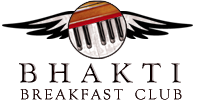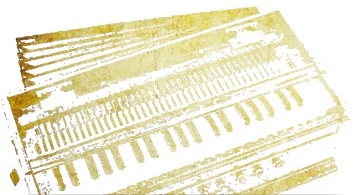



 |

Kirtan+ConfettiMusic and Mantra playlists |
 |

Learn harmonium!Online music classes |
 |

Krishna Das
|








 |

Kirtan+ConfettiMusic and Mantra playlists |
 |

Learn harmonium!Online music classes |
 |

Krishna Das
|
 posted by Daniel on October 10th, 2010
posted by Daniel on October 10th, 2010Crack! The hammer hits home, sending a loose piece of splintered pine wood flying. I re-close the harmonium's box, pump the bellows - and - it still plays! Gosh, does it sound even better? Perhaps the sound board resonates more fully, relieved of its encumbrance.
 |
It's a music dork's demolition derby today, as I seek to understand: What are the crucial elements that make up a harmonium? And what elements of current harmoniums are unnecessary? expendable? better suited for the trash can, or the annals of history?
First to go is the coupling device, which links each key on the keyboard with a key an octave higher. Most players never use it, and I find that the device stiffens the keyboard's action in an unsatisfying way. So, off it goes, lightening the whole instrument and making it mechanically more streamlined (simpler).
Next, I strip out the six knobs. These vestigial apparati perform borderline useless functions. I have tried to adapt the drone knobs to Western music use by stipulating "white key" notes be installed (C and A for example) instead of Indian-favored "black key" notes (such as C# and G#). Still, drone notes are generally incompatible with moving chord progressions, which are the underpinning of Western music, and of most Western musicians' approach to playing kirtan on harmonium. So, the drone knobs rarely get used, if ever. Then there's the vibrato knob. I *dare* somebody to post a you-tube video displaying an aesthetically pleasing use for this sound effect. Finally, there's the air knobs. Open the harmonium, pull them out. Remember to push them in when you close the harmonium. We all know the drill... but... do we really need them? All they do is allow the air to move from the bellows to the reeds. Why not have that passageway permanently open? Off they go, along with their corresponding wooden blocks, screws, and rods.
With the knobs removed, the harmonium has both sets of reeds permanently on - so, no need for the wood strips that divide the upper and lower reed chambers. In fact, each of these sets of reeds when played independently has a quirky, fickle character, which leads us all to play with both open at all times. Thereby, the dividing boards are unnecessary. Out come the hammer and chisel, sending sections of splintered pine wood strips flying through the workshop.
Just under the bottom tray of the inner box, I see some folded leather. Curious, I unscrew the tray and lift it out - and discover an entire second bellows housed in the harmonium's bottom box, under the inner box's tray. Fitted with two large coiled springs beneath it and a one-way air-flow valve (a leather flap), this second bellows glares at me, challenging: I may seem extraneous, but perhaps I am essential.
I perform some tests. I remove the springs, replace the rest and play. The harmonium sounds, but dies intermittently as my hand moves away to catch the next pump. In an instant, I grok the function of the second bellows: to enable the harmonium to produce a consistent sound by blowing the reeds with a consistent air pressure, rather than a periodic sound which would be produced if the reeds were played directly by the primary bellows, with is pumped periodically by a hand.
Herein, I realize, is the crucial difference between two species of free-reed keyboard instruments: the harmonium, and the accordion. A single bellows pumping a single reed will inevitably have an unsatisfying gap in its sound when the bellows is reset, in preparation for a future pump. The method for overcoming this periodicity, and producing a sustained sound, is the crucial distinction between harmonium and accordion.
Accordions overcome this challenge by having double reeds. Each metal reed plate has two reeds - side by side. One is played as the bellows are squeezed toward each other, and the other is played when the bellows are drawn back apart. Thereby, the illusion of a continuous sound, actually produced by two separate sets of reeds. Meanwhile, the harmonium overcomes the same challenge with a different mechanical approach: Use one set of reeds, but play it with continual air pressure by having an intermediary bellows - a bladder, or ballast really.
Just as a trumpeter employs puffed cheeks in the playing of his horn while he breaths in through his nose, in order to produce a continuous stream of pressurized air (circular breathing), the harmonium employs this spring-pushed (instead of hand-pushed) secondary bellows.
Fascinating!
| [see permalink] |